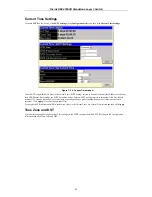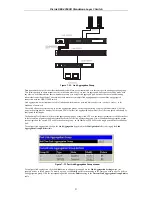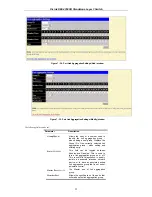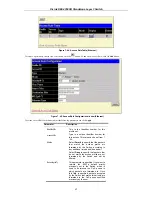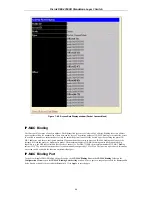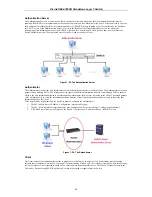
D-Link DES-3350SR Standalone Layer 3 Switch
57
specify what protocol(s) to include
according to the following guidelines:
Select
ICMP
to instruct the Switch to
examine the Internet Control Message
Protocol (ICMP) field in each frame's
header.
Select
Type
to further specify that the
access profile will apply an ICMP type
value, or specify Code to further specify
that the access profile will apply an ICMP
code value.
Select
IGMP
to instruct the Switch to
examine the Internet Group Management
Protocol (IGMP) field in each frame's
header.
Select
Type
to further specify that the
access profile will apply an IGMP type
value
Select
TCP
to use the TCP port number
contained in an incoming packet as the
forwarding criterion. Selecting TCP
requires that you specify a source port
mask and/or a destination port mask.
src port mask
- Specify a TCP port
mask for the source port in hex form (hex
0x0-0xffff), which you wish to filter.
dest port mask
- Specify a TCP port
mask for the destination port in hex form
(hex 0x0-0xffff) which you wish to filter.
Select
UDP
to use the UDP port number
contained in an incoming packet as the
forwarding criterion. Selecting UDP
requires that you specify a source port
mask and/or a destination port mask.
src port mask
- Specify a TCP port
mask for the source port in hex form (hex
0x0-0xffff).
dest port mask
- Specify a TCP port
mask for the destination port in hex form
(hex 0x0-0xffff).
protocol id
- Enter a value defining the
protocol ID in the packet header to mask.
Specify the protocol ID mask in hex form
(hex 0x0-0xffffffff).
Port
The user may set the
Access Profile
Table
on a per-port basis by entering an
entry in this field. Entering all will denote
all ports on the Switch. The port list is
specified by listing the lowest switch
number and the beginning port number
on that switch, separated by a colon.
Then the highest switch number, and the
highest port number of the range (also
separated by a colon) are specified. The
beginning and end of the port list range
are separated by a dash. For example,
1:3 specifies switch number 1, port 3. 2:4
specifies switch number 2, port 4. 1:3 -
2:4 specifies all of the ports between
switch 1, port 3 and switch 2, port 4
−
in
numerical order.
Packet Content Mask
The page shown below is the
Packet Content Mask
configuration window.
Summary of Contents for DES-3350SR
Page 1: ...D Link DES 3350SR Standalone Layer 3 Switch User s Guide...
Page 80: ...D Link DES 3350SR Standalone Layer 3 Switch 70 Figure 7 57 The Client...
Page 138: ...D Link DES 3350SR Standalone Layer 3 Switch 128 Click Apply to implement changes made...
Page 160: ...D Link DES 3350SR Standalone Layer 3 Switch 150 Figure 10 33 PIM Neighbor Table...
Page 188: ......

